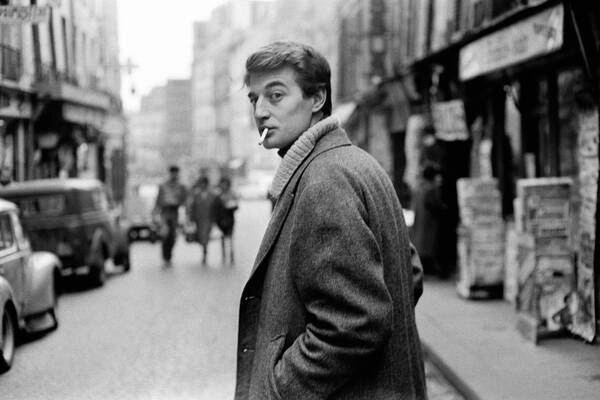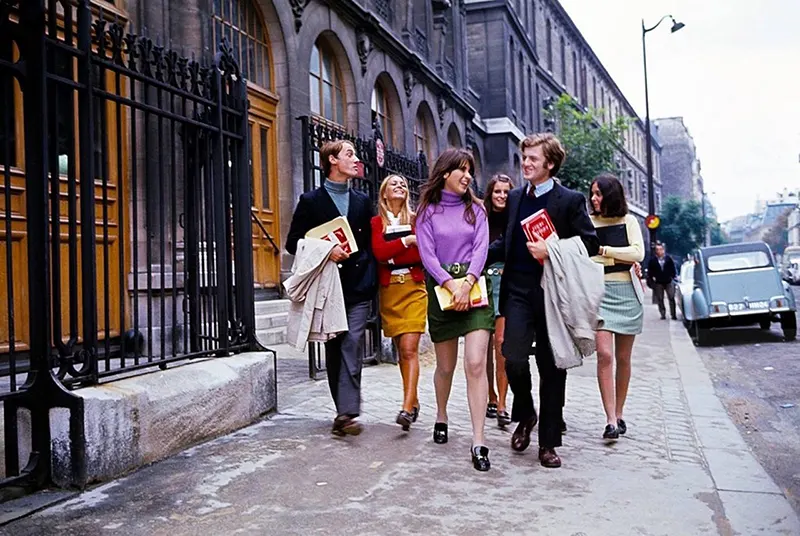Django et fils :)
Hommage à Django Reinhardt - 1960 (Colorized)
#docu #archive #jazz #quintet #guitare #violon #sixties #manouches #DjangoReinhardt #Grappelli
One person like that
#docu #archive #jazz #quintet #guitare #violon #sixties #manouches #DjangoReinhardt #Grappelli

#news #cinéma #Jules-et-jim #Truffaut #Moreau #sixties #classique #chef-d’oeuvre #Serre
Mort d’ Henri Serre le Jim du célèbre binôme amical dans «Jules et Jim» amoureux de Jeanne Moreau de François Truffaut en 1962,
https://rarehistoricalphotos.com/paris-street-scenes-vintage-photos/
Vintage Color Photos Capture Street Scenes of Paris in the 1960s

These fascinating color photographs capture street scenes of Paris in the 1960s. In 1958, Charles de Gaulle formed a new government and the Fifth Republic was born.
During the ten years that de Gaulle occupied the presidency, France and Paris experienced rapid economic growth, which was accompanied by the building of new office buildings and housing, and the rehabilitation of historic neighborhoods in the center of the city.
De Gaulle’s Minister of Culture, André Malraux, oversaw the reconstruction of the historic neighborhoods in the center, particularly Le Marais.
In Le Marais and the other designated historic zones, the rehabilitation consisted of leaving the façade and walls intact, while rebuilding completely the interior of the building.
The Malraux law also required that the façades of buildings be scrubbed clean of centuries of accumulated soot and dirt. The most visible improvement was the cleaning of the cathedral of Notre Dame, which in a few months turned from black to white.

Arc de Triomphe , Champs-Elysées, Paris, 1960. Photo: Charles Weever Cushman.
In other neighborhoods in the center of the city, the rehabilitation took a different form: residential buildings of the Haussmann era were transformed into offices.
As the price of land doubled in the city center, middle class residents moved out to the suburbs. Dilapidated and crumbling residential buildings were torn down and replaced by office buildings. The population of the arrondissements in the city center markedly decreased.
The neighborhood of the central market of Les Halles was also a target for renewal. The old market was too small and traffic around it too congested to serve the needs of the growing city.
One of the historic pavilions was preserved and moved to a park outside the city, but the others were closed down and the site, after long debate, was eventually turned into a park and underground commercial space, the Forum des Halles.
Until the 1960s there were no tall buildings in Paris to share the skyline with the Eiffel Tower, the tallest structure in the city; a strict height limit of thirty-five meters was in place.
However, in October 1958, under the Fifth Republic, in order to permit the construction of more housing and office buildings, the rules began to change. A new urban plan for the city was adopted by the municipal council in 1959.
Higher buildings were permitted, as long as they met both technical and aesthetic standards. The first new tower to be constructed was an apartment building, the Tour Croulebarbe, at 33 rue Croulebarbe in the 13th arrondissement.
It was twenty-two stories, and sixty-one meters high, and was completed in 1961. Between 1960 and 1975, about 160 new buildings higher than fifteen stories were constructed in Paris, more than half of them in the 13th and 15th arrondissements.
The most important project of de Gaulle’s government was the construction of a new business district at La Défense, just west of the city limits.
The idea was to create a new business center, since there was no more room to build in the traditional business center, around the Opera; and also to extend the historic axis of the city, an imaginary east-west line which ran from the porte-Maillot at the eastern edge of the city to Place de la Bastille, to the Louvre, and through the Place de la Concorde along the Champs Élysées to the Arc de Triomphe.
It allowed the creation of a French version of Manhattan, without disturbing the skyline and architecture of the historic center of the city.
In the suburbs of Paris, the process of de-industrialization was already under way before de Gaulle. Under the Fourth Republic, enterprises had been required to get government approval for every new industrial building over 500 square meters, and to pay heavy charges to subsidize transportation and other services. The government also paid a subsidy for the demolition of old factory buildings.
The rising price of land was a major factor in the move of industry out of the city and the suburbs to other regions. Between 1960 and 1966, 352,000 square meters of industrial buildings was destroyed a year, while only 295,000 square meters was built.
By 1960, the industrial space of the Paris region represented only 10 percent of the national total.

Rue de la Montagne Ste. Geneviere, Paris, 1960. Photo: Charles Weever Cushman.

Rue Mont Genis, Montmartre, Paris, 1960. Photo: Charles Weever Cushman.



Champs-Élysées, Paris, 1961. (More at: Pissoirs: The vintage public urinals of Paris, 1865-1875).

Stamp collectors on Champs-Élysées, Paris, 1967.

Pond boats, Jardin des Tuileries, Paris, 1968.

Top of the Arc de Triomphe, Paris, 1968.
(Photo credit: Charles W. Cushman Photograph Collection via University of Indiana / Flickr / Pinterest / Wikimedia Commons).

Chronique film : Goliath et l'Hercule noir de Mario Caiano (avec Gordon Scott, Ombretta Colli, Gloria Milland, Mimmo Palmara, Giuseppe Fortis, Serge Nubret, Paola Petrini, Nadia Du Monteil, Mirko Ellis…) 1963
https://www.nawakulture.fr/critiques-films/dvd-bluray/8937-goliath-et-l-hercule-noir-de-mario-caiano-avec-gordon-scott-ombretta-colli-gloria-milland-mimmo-palmara-giuseppe-fortis-serge-nubret-paola-petrini-nadia-du-monteil-mirko-ellis-1963
#nawakulture #article #chronique #critique #cinéma #film #aventure #fantastique #mythologie #peplum #goliath #sardes #lydie #antiquité #mariocaiano #gordonscott #kitsch #sixties
https://www.youtube.com/watch?v=o83gLvDdSG8
#Honeycombs #Sixties #The-Honeycombs #Beat #Music #Musik #YouTube #Video #Wikipedia
#jazz and #pop from #sixties in a single word: #burtbacharach -- 4 pieces from the american composer, performed with #trumpet, #guitar and #bass:https://flaviotothemoon.bandcamp.com/album/hello-burt
Eve of Destruction (1965)
The eastern world it is explodin', violence flarin', bullets loadin'
You're old enough to kill but not for votin'
You don't believe in war, what's that gun you're totin'
And even the Jordan river has bodies floatin'
But you tell me over and over and over again my friend
Ah, you don't believe we're on the eve of destruction
Don't you understand, what I'm trying to say?
Can't you see the fear that I'm feeling today?
If the button is pushed, there's no running away
There'll be none to save with the world in a grave
Take a look around you, boy, it's bound to scare you, boy
But you tell me over and over and over again my friend
Ah, you don't believe we're on the eve of destruction
Yeah, my blood's so mad, feels like coagulatin'
I'm sittin' here just contemplatin'
I can't twist the truth, it knows no regulation
Handful of Senators don't pass legislation
And marches alone can't bring integration
When human respect is disintegratin'
This whole crazy world is just too frustratin'
And you tell me over and over and over again my friend
Ah, you don't believe we're on the eve of destruction
Think of all the hate there is in Red China
Then take a look around to Selma, Alabama
Ah, you may leave here for four days in space
But when you return it's the same old place
The poundin' of the drums, the pride and disgrace
You can bury your dead but don't leave a trace
Hate your next door neighbor but don't forget to say grace
And you tell me over and over and over and over again my friend
Ah, you don't believe we're on the eve of destruction
#PFSloan #RIP #peace #love #NoWar #NoHate #BarryMcguire #sixties
https://www.youtube.com/watch?v=ouR1V14mwb8